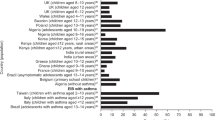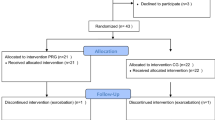Abstract
Background Exercise-triggered asthma (ETA) develops when physical activity triggers asthma symptoms during or directly after exercise. In patients prone to symptoms of supra-esophageal reflux, exercise may trigger gastroesophageal reflux (GER), resulting in such symptoms. Aims To determine the prevalence of abnormal pH in patients with ETA and to determine whether acid suppression improves symptoms in ETA patients. Methods We performed a randomized double-blind trial of rabeprazole versus placebo in the treatment of patients with ETA. Patients underwent treadmill protocol to determine their VO2max. Next, pH testing was initiated while undergoing a 30-min treadmill program exercising them at 65% of their VO2max. They were subsequently randomized to rabeprazole or placebo for 10 weeks. At the end of 10 weeks, exercise testing was repeated. Results A total of 31 patients completed the study (20 asthmatics, 11 non-asthmatics). Twenty-two out of 30 (73%) subjects had abnormal pH studies. For all subjects, rabeprazole improved symptoms more than placebo (P = 0.03). The association was stronger in the pH-positive group (P = 0.009). Conclusion Acid reflux is common in ETA patients. Many patients with exercise-related respiratory symptoms are misdiagnosed as chronic asthmatics. Exercise-related symptoms improve with the use of acid suppression. This study suggests that ETA patients may benefit from acid suppression.




Similar content being viewed by others
References
Storms WW (2005) Asthma associated with exercise. Immunol Allergy Clin North Am 25(1):31–43. doi:10.1016/j.iac.2004.09.007
Hermansen CL, Kirchner JT (2004) Identifying exercise-induced bronchospasm. Treatment hinges on distinguishing it from chronic asthma. Postgrad Med 115(6):15-6–21-5
Parsons JP, Mastroade JG (2005) Exercise-induced bronchoscontriction in athletes. Chest 128(6):3966–3974. doi:10.1378/chest.128.6.3966
Weiner P, Konson N, Sternberg A et al (1998) Is gastroesophageal reflux a factor in exercise induced asthma? Respir Med 92:1071–1075. doi:10.1016/S0954-6111(98)90357-2
Hogan WJ (1997) Spectrum of supraesophageal complications of gastroesophageal reflux disease. Am J Med 103(5A):77S–83S. doi:10.1016/S0002-9343(97)00329-x
Harding SM (2001) Gastroesophageal reflux, asthma, and mechanisms of interaction. Am J Med 111(8A):8S–12S. doi:10.1016/S0002-9343(01)00817-8
Kraus BB, Sinclair JW, Castell DO (1990) Gastroesophageal reflux in runners. Ann Intern Med 112:429–433
Clark CS, Kraus BB, Sinclair J et al (1989) Gastroesophageal reflux induced by exercise in healthy volunteers. JAMA 261(24):3599–3601. doi:10.1001/jama.261.24.3599
Banwait KS, Harnois DM, Tighe D et al (2004) The effect of exercise on the esophageal body and lower esophageal sphincter in normal and subjects with gastroesophageal reflux disease (GERD). Gastroenterology 126(4)Suppl 2:A-500–A-501:T1731
Maddison KJ, Shepherd KL, Hillman DR et al (2005) Function of the lower esophageal sphincter during and after high-intensity exercise. Med Sci Sports Exerc 37(10):1728–1733. doi:10.1249/01.mss.0000175051.47170.33
Sharma A, Levey J (2003) Gastroesophageal reflux disease in runners. AMAA J 16(1):7–11
Maddison K, Shepherd K, Hillman D et al (2005) Function of the lower esophageal sphincter during and after high-intensity exercise. Med Sci Sports Exerc 37:1728–1733. doi:10.1249/01.mss.0000175051.47170.33
Bagnato GF, Gulli S, Giacobbe O et al (2000) Bronchial hyperresponsiveness in subjects with gastroesophageal reflux. Respiration 67:507–509. doi:10.1159/000067464
National Asthma Education and Prevention Program (2007) Expert panel report III: guidelines for the diagnosis and management of asthma. National Heart, Lung, and Blood Institute, Bethesda, MD, NIH publication no. 08-4051
Dobhan R, Castell DO (1993) Normal and abnormal proximal acid exposure; results of ambulatory dual probe pH monitoring. Am J Gastroenterol 88:25–30
Demeester J, Johnson D (1974) 24 hour pH monitoring of distal esophagus. Am J Gastroenterol 62:323–332
Littner MR, Leung FW, Ballard ED et al (2005) Effects of 24 weeks of lansoprazole therapy on asthma symptoms, exacerbations, quality of life and pulmonary function in adult asthmatic subjects with acid reflux symptoms. Chest 128:1128–1135. doi:10.1378/chest.128.3.1128
Kilijander TO, Harding SM, Field SK et al (2006) Effects of esomeprazole 40 mg twice daily on asthma. Am J Respir Crit Care Med 173:191–1097
Kilijander TO, Salomaa ER, Hietanen EK et al (1999) Gastroesophageal reflux in asthmatics: a double-blind, placebo-controlled crossover study with omeprazole. Chest 116(5):1257–1264. doi:10.1378/chest.116.5.1257
Boeree MJ, Peters FTM, Postrna DS et al (1998) No effects of high dose omeprazole in subjects with severe airway hyper-responsiveness and (a)symptomatic gastroesophageal reflux. Eur Respir J 11:1070–1074. doi:10.1183/09031936.98.11051070
Harding SM, Richter JE (1997) The role of gastroesophageal reflux in chronic cough and asthma. Chest 111:1389–1402. doi:10.1378/chest.111.5.1389
Vincent D, Cohen-Jonathan AM, Leport J et al (1997) Gastro-esophageal reflux prevalence and relationship with bronchial reactivity in asthma. Eur Respir J 10:2255–2259. doi:10.1183/09031936.97.10102255
Field SK, Evans JA, Price LM (1998) The effects of acid perfusion of the esophagus on ventilation and respiratory sensation. Am J Respir Crit Care Med 157:1058–1062
Kiljander TO, Salomaa ER, Hietanen Ek et al (2002) Gastroesophageal reflux and bronchial hyperresponsiveness: correlation and the effect of fundoplication. Respiration 69:434–439. doi:10.1159/000064021
Jiang SP, Liang RY, Zeng ZY et al (2003) Effects of antireflux treatment on bronchial hyperresponsiveness and lung function in asthmatic subjects with gastroesophageal reflux disease. World J Gastroenterol 9:1123–1125
Soffer EE, Merchant RK, Duethman G et al (1993) Effect of graded exercise on esophageal motility and gastroesophageal reflux in trained athletes. Dig Dis Sci 38:220–224. doi:10.1007/BF01307538
Soffer EE, Wilson J, Duethman G et al (1994) Effect of graded exercise on esophageal motility and gastroesophageal reflux in nontrained subjects. Dig Dis Sci 39:193–198. doi:10.1007/BF02090082
Van Nieuwenhoven MA, Brummer RJM, Brouns F (2000) Gastrointestinal function during exercise: comparison of water, sports drink, and sports drink with caffeine. J Appl Physiol 89:1079–1085
Corley DA, Levin TR, Habel LA, Buffler PA (2006) Barrett’s esophagus and medications that relax the lower esophageal sphincter. Am J Gastroenterol 101:937–944. doi:10.1111/j.1572-0241.2006.00539.x
Lagergren J, Bergstrom R, Adami H, Nyren O (2000) Association between medications that relax the LES and esophageal adenocarcinoma. Ann Intern Med 133:165–175
Mainie I, Tatuian R et al (2006) Acid and non-acid reflux in patients with persistent symptoms despite acid suppressive therapy; a multi-centre study using combined ambulatory impedance monitoring. Gut 55:1398–1402. doi:10.1136/gut.2005.087668
Charbel S, Khandwala F, Vaezi M (2005) The role of esophageal pH monitoring in symptomatic Subjects on PPI therapy. Am J Gastroenterol 100:283–289. doi:10.1111/j.1572-0241.2005.41210.x
Acknowledgments
Declaration of personal interests:
Dr. Kathryn Peterson received research support from PriCara, unit of Ortho-McNeil, Inc. and the AGA Foundation. No other personal interests exist.
Declaration of Funding Interests
This study was funded in part by PriCara, unit of Ortho-McNeil, Inc. and the AGA Foundation for the 2000 Fellowship to Faculty Award.
Author information
Authors and Affiliations
Corresponding author
Rights and permissions
About this article
Cite this article
Peterson, K.A., Samuelson, W.M., Ryujin, D.T. et al. The Role of Gastroesophageal Reflux in Exercise-Triggered Asthma: A Randomized Controlled Trial. Dig Dis Sci 54, 564–571 (2009). https://doi.org/10.1007/s10620-008-0396-6
Received:
Accepted:
Published:
Issue Date:
DOI: https://doi.org/10.1007/s10620-008-0396-6




